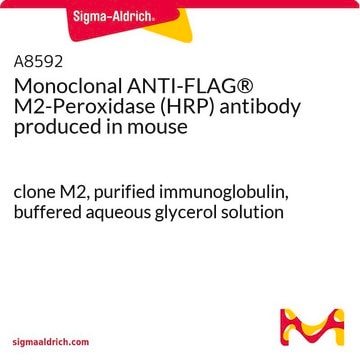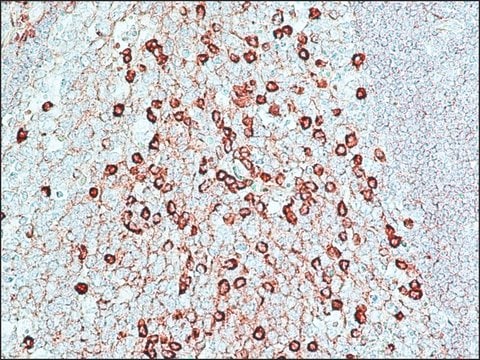P2419
Monoclonal Anti-Peroxidase antibody produced in mouse
clone P6-38, ascites fluid
Iniciar sesiónpara Ver la Fijación de precios por contrato y de la organización
About This Item
Productos recomendados
origen biológico
mouse
conjugado
unconjugated
forma del anticuerpo
ascites fluid
tipo de anticuerpo
primary antibodies
clon
P6-38, monoclonal
contiene
15 mM sodium azide
reactividad de especies
horseradish
técnicas
indirect ELISA: 1:5,000 using mouse primary antibody, bridging antibody and horseradish peroxidase
isotipo
IgG1
Condiciones de envío
dry ice
temp. de almacenamiento
−20°C
modificación del objetivo postraduccional
unmodified
Descripción general
Monoclonal anti-peroxidase (mouse IgG1 isotype) is derived from the hybridoma produced by the fusion of mouse myeloma cells and splenocytes from an immunized mouse.
Inmunógeno
horseradish peroxidase
Aplicación
Monoclonal Anti-Peroxidase antibody may be used for:
- immunocytochemistry
- indirect ELISA (1:5,000)
- immunohistochemistry
- immunoblotting
Acciones bioquímicas o fisiológicas
Peroxidase is often used as an enzyme label for antibodies during analyses of target antigens. Peroxidases aids in substrate conversion indicated by the formation of a coloured product. In an alternative procedure, an anti-enzyme antibody can be used to bridge a primary antibody and enzyme complex for the study of target proteins. Anti-peroxidase antibodies are also used to prepare peroxidase-anti-peroxidase (PAP) soluble complexes. Monoclonal Anti-Peroxidase antibody can be used for signal amplification in a wide range of immunological techniques. The product is specific for horseradish peroxidase. Such immunoassays are useful tools to detect antigens, toxins, bacteria and viruses.
Cláusula de descargo de responsabilidad
Unless otherwise stated in our catalog or other company documentation accompanying the product(s), our products are intended for research use only and are not to be used for any other purpose, which includes but is not limited to, unauthorized commercial uses, in vitro diagnostic uses, ex vivo or in vivo therapeutic uses or any type of consumption or application to humans or animals.
¿No encuentra el producto adecuado?
Pruebe nuestro Herramienta de selección de productos.
Código de clase de almacenamiento
10 - Combustible liquids
Clase de riesgo para el agua (WGK)
nwg
Punto de inflamabilidad (°F)
Not applicable
Punto de inflamabilidad (°C)
Not applicable
Elija entre una de las versiones más recientes:
¿Ya tiene este producto?
Encuentre la documentación para los productos que ha comprado recientemente en la Biblioteca de documentos.
Leonid P Nezlin et al.
The Journal of comparative neurology, 464(3), 257-268 (2003-08-06)
Structural and functional investigations were carried out to study olfactory glomeruli in the main olfactory bulb (OB) in tadpoles of the clawed frog, Xenopus laevis. Calcium imaging of odor response patterns of OB neurons revealed that the synapses within the
Nuestro equipo de científicos tiene experiencia en todas las áreas de investigación: Ciencias de la vida, Ciencia de los materiales, Síntesis química, Cromatografía, Analítica y muchas otras.
Póngase en contacto con el Servicio técnico








